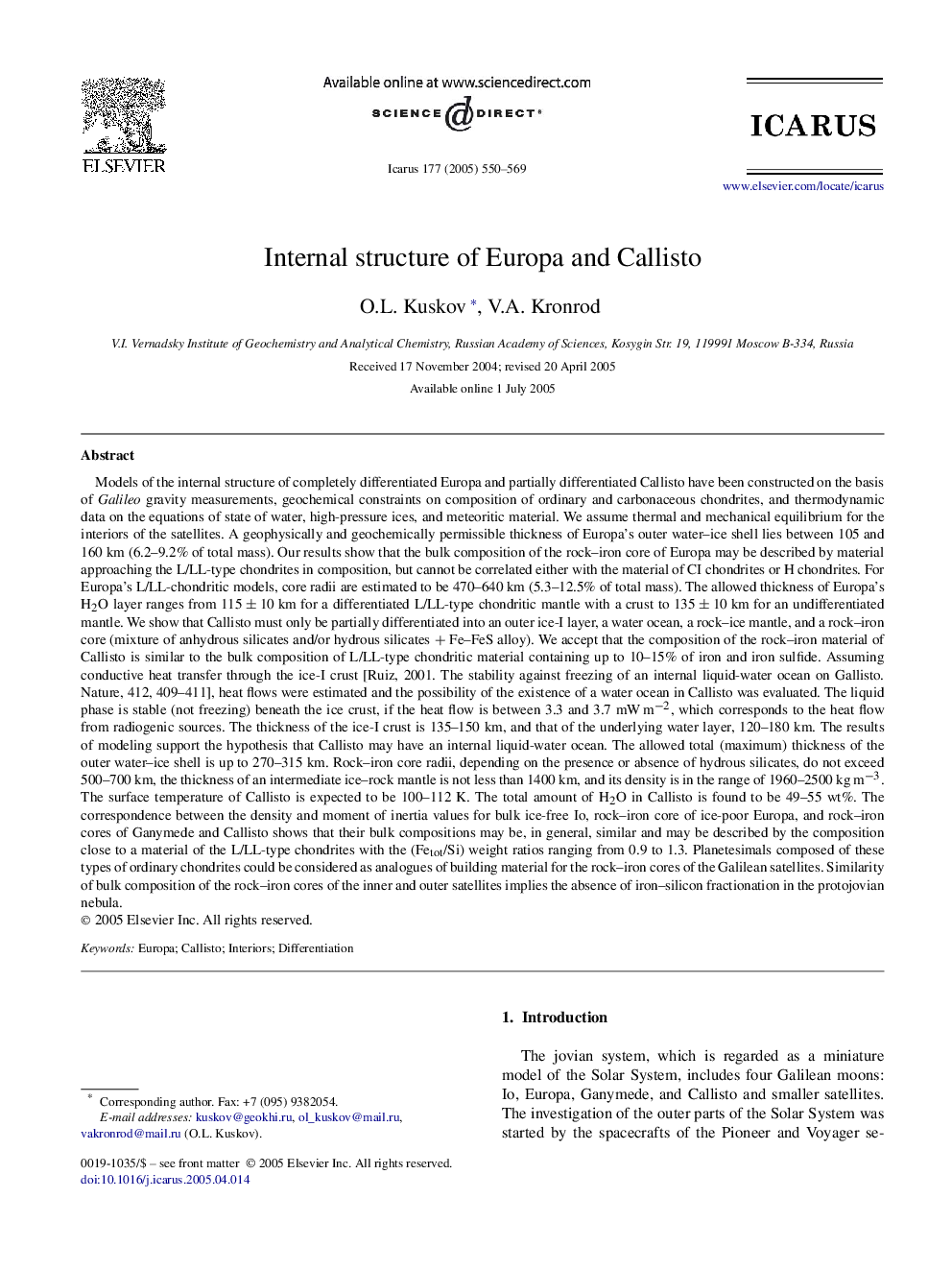| کد مقاله | کد نشریه | سال انتشار | مقاله انگلیسی | نسخه تمام متن |
|---|---|---|---|---|
| 10701942 | 1021222 | 2005 | 20 صفحه PDF | دانلود رایگان |
عنوان انگلیسی مقاله ISI
Internal structure of Europa and Callisto
دانلود مقاله + سفارش ترجمه
دانلود مقاله ISI انگلیسی
رایگان برای ایرانیان
موضوعات مرتبط
مهندسی و علوم پایه
علوم زمین و سیارات
علوم فضا و نجوم
پیش نمایش صفحه اول مقاله

چکیده انگلیسی
Models of the internal structure of completely differentiated Europa and partially differentiated Callisto have been constructed on the basis of Galileo gravity measurements, geochemical constraints on composition of ordinary and carbonaceous chondrites, and thermodynamic data on the equations of state of water, high-pressure ices, and meteoritic material. We assume thermal and mechanical equilibrium for the interiors of the satellites. A geophysically and geochemically permissible thickness of Europa's outer water-ice shell lies between 105 and 160 km (6.2-9.2% of total mass). Our results show that the bulk composition of the rock-iron core of Europa may be described by material approaching the L/LL-type chondrites in composition, but cannot be correlated either with the material of CI chondrites or H chondrites. For Europa's L/LL-chondritic models, core radii are estimated to be 470-640 km (5.3-12.5% of total mass). The allowed thickness of Europa's H2O layer ranges from 115±10 km for a differentiated L/LL-type chondritic mantle with a crust to 135±10 km for an undifferentiated mantle. We show that Callisto must only be partially differentiated into an outer ice-I layer, a water ocean, a rock-ice mantle, and a rock-iron core (mixture of anhydrous silicates and/or hydrous silicates + FeFeS alloy). We accept that the composition of the rock-iron material of Callisto is similar to the bulk composition of L/LL-type chondritic material containing up to 10-15% of iron and iron sulfide. Assuming conductive heat transfer through the ice-I crust [Ruiz, 2001. The stability against freezing of an internal liquid-water ocean on Gallisto. Nature, 412, 409-411], heat flows were estimated and the possibility of the existence of a water ocean in Callisto was evaluated. The liquid phase is stable (not freezing) beneath the ice crust, if the heat flow is between 3.3 and 3.7 mWâmâ2, which corresponds to the heat flow from radiogenic sources. The thickness of the ice-I crust is 135-150 km, and that of the underlying water layer, 120-180 km. The results of modeling support the hypothesis that Callisto may have an internal liquid-water ocean. The allowed total (maximum) thickness of the outer water-ice shell is up to 270-315 km. Rock-iron core radii, depending on the presence or absence of hydrous silicates, do not exceed 500-700 km, the thickness of an intermediate ice-rock mantle is not less than 1400 km, and its density is in the range of 1960-2500 kgâmâ3. The surface temperature of Callisto is expected to be 100-112 K. The total amount of H2O in Callisto is found to be 49-55 wt%. The correspondence between the density and moment of inertia values for bulk ice-free Io, rock-iron core of ice-poor Europa, and rock-iron cores of Ganymede and Callisto shows that their bulk compositions may be, in general, similar and may be described by the composition close to a material of the L/LL-type chondrites with the (Fetot/Si) weight ratios ranging from 0.9 to 1.3. Planetesimals composed of these types of ordinary chondrites could be considered as analogues of building material for the rock-iron cores of the Galilean satellites. Similarity of bulk composition of the rock-iron cores of the inner and outer satellites implies the absence of iron-silicon fractionation in the protojovian nebula.
ناشر
Database: Elsevier - ScienceDirect (ساینس دایرکت)
Journal: Icarus - Volume 177, Issue 2, October 2005, Pages 550-569
Journal: Icarus - Volume 177, Issue 2, October 2005, Pages 550-569
نویسندگان
O.L. Kuskov, V.A. Kronrod,